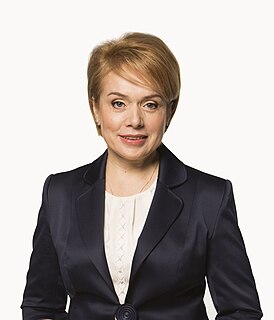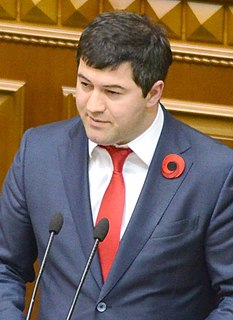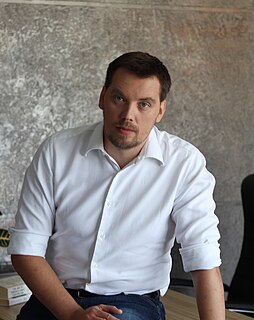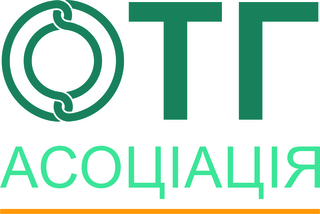
The administrative divisions of Ukraine are subnational administrative divisions within the geographical areas of Ukraine under the jurisdiction of the Ukrainian Constitution. The first level of subdivision consists of 27 regions:

Ukrainian Railways is a state-owned joint-stock company of rail transport in Ukraine, a monopoly that controls the vast majority of the railroad transportation in the country. It possesses a combined total track length of over 23,000 km, making it the 13th largest in the world. Ukrainian Railways is also the world's 6th largest rail passenger transporter and world's 7th largest freight transporter.

Zaporizhzhia International Airport is the international airport that serves Zaporizhzhia, Ukraine one of three airfields around the city. The aircraft engine factory Motor Sich has its base here. In May 2020 the airport was extended with a new terminal with a capacity of 400 passengers.
Hromada is a basic unit of administrative division in Ukraine, similar to a municipality. Established by the Government of Ukraine on 12 June 2020. Similar terms exist in Poland (gromada) and in Belarus (hramada). The literal translation of this term is "community", similarly to the terms used in western European states, such as Germany (gemeinde), France (commune) and Italy (comune).
The local government in Ukraine consists of two systems based on administrative divisions of Ukraine. There are 24 oblasts, the Autonomous Republic of Crimea, and two city councils with special status (regions), with each region further divided into amalgamated hromadas and raions (districts).

The Armed Forces of Ukraine is the military of Ukraine. They are the principal deterrent force against any aggression that could be shown against the sovereign state of Ukraine. All military and security forces, including the Armed Forces, are under the command of the President of Ukraine, and subject to oversight by a permanent Verkhovna Rada parliamentary commission.

Mavkovychi is a village (selo) in Lviv Raion, Lviv Oblast (province) of western Ukraine. It belongs to Horodok urban hromada, one of the hromadas of Ukraine. Mavkovychi is located along the way Horodok - Velykyi Liubin. Local government —Kernytska village council. The first mention of Mavkovychi dates from the year 1490. Then the village has received Magdeburg rights.

Liliia Mykhailivna Hrynevych is a Ukrainian educator, politician and civil servant, a Member of the Parliaments of the 7th and 8th Convocation from December 2012 to April 2016. From April 2016 to August 2019 —the Minister of Education and Science of Ukraine; the first woman-Minister of Education and Science in the period of the Ukrainian independence. She has a PHD in Education.
The SCE-200 is an Indian, under-development, liquid-fuel rocket engine, burning liquid oxygen (LOX) and RP-1 kerosene in an oxidizer-rich staged combustion cycle. This engine is expected to power Indian Space Research Organization's upcoming Unified Launch Vehicle (ULV) and Reusable Launch Vehicle (RLV). It is being developed by the Liquid Propulsion Systems Centre, a subsidiary of ISRO. But before that it will be tested on a GSLV Mk III by replacing the L110 stage powered by the Vikas engine with an SC-200 stage powered by SCE-200 engine and a 200 tonne propellant load.

Kernytsia is a village (selo) in Lviv Raion, Lviv Oblast, of Western Ukraine. Chuchenosy villages name has been in antiquities. The modern name of village was constituted in 1780. It belongs to Horodok urban hromada, one of the hromadas of Ukraine. Local government is administered by Kernytska village council.

Hennadiy Zubko is a Ukrainian politician. From 2 December 2014 until 29 August 2019 he was the Deputy Prime Minister — Minister for Regional Development, Construction and Housing, serving in the second Yatsenyuk Government of Arseniy Yatsenyuk and in the Groysman Government of Volodymyr Groysman.

State Fiscal Service or SFS is a government agency of Ukraine that in 2014 replaced the Ministry of Revenues and Duties. The former ministry was created back in 2012 by the Second Azarov Government through merging the State Tax Service and the State Customs Service.

Roman Mykhailovych Nasirov is a Ukrainian politician who served as the Head of the State Fiscal Service of Ukraine. He was temporarily relieved of his duties on 3 March 2017 and although he was reinstated in his function by a court decision late 2018 he did not return as head of the State Fiscal Service.
Prozorro.Sale is a state-owned enterprise managed by the Ministry of Economy. The enterprise is an online electronic auction system of the same name for the sale and lease of property. The SOE "Prozorro.Sale" administers this IT system, which guarantees the bid security, technical reliability and non-interference in auctions.

Volodymyr Volodymyrovych Omelyan is a Ukrainian diplomat and politician. He is a former Ukraine's infrastructure minister in the government of Volodymyr Groysman.
An amalgamated hromada or amalgamated territorial community, also known as a united territorial community, was a special unit of administrative division in Ukraine from 2015 to 2020. First created in 2015, amalgamated hromadas were formed through the voluntary merger of preexisting hromadas, a form of third-level administrative unit including cities, villages, urban-type settlements, and rural settlements, to form a new enlarged administrative unit. On 6 March 2020 Prime Minister Denys Shmyhal stated that 1,045 amalgamated hromadas had been established and that 350 more had to be created. As of 2020 the amalgamated hromadas already took over most tasks of the raions.

In the year 2000, Rwanda engaged in a decentralization process materialized by the adoption of the National Decentralization Policy. The policy's objective were the promotion of good governance, the reduction of poverty as well as the promotion of efficient, effective, and accountable service delivery.

Oleksiy Valeriyovych Honcharuk is a Ukrainian politician. He served as the Prime Minister of Ukraine from 29 August 2019 to 4 March 2020 following a landslide parliamentary election win. Honcharuk was replaced by Denys Shmyhal during the formation of the Shmyhal Government.

The Association of Amalgamated Territorial Communities is an organization of municipal government representing over 490 Ukrainian amalgamated municipalities. Its stated purpose is to provide political and strategic leadership to represent the interests of local municipalities established in the process of voluntary association of territorial communities after Euromaidan. The AACT was founded in 2016.
Rzhyshchiv urban hromada is a hromada in Ukraine, in Obukhiv Raion of Kyiv Oblast. The administrative center is the city of Rzhyshchiv.














